Abstract
1. We have studied the effects of changes in posture on the motor response to galvanic vestibular stimulation (GVS). The purpose of the experiments was to investigate whether the function of the GVS-evoked response is to stabilize the body or the head in space. Subjects faced forwards with eyes closed standing with various stance widths and sitting. In all cases the GVS-evoked response consisted of a sway of the body towards the anodal ear. 2. In the first set of experiments the response was measured from changes in (i) electromyographic activity of hip and ankle muscles, (ii) the lateral ground reaction force, and (iii) lateral motion of the body at the level of the neck (C7). For all measurements the response became smaller as the feet were placed further apart. 3. In the second set of experiments we measured the GVS-evoked tilts of the head, torso and pelvis. The basic response consisted of a tilt in space (anodal ear down) of all three segments. The head tilted more than the trunk and the trunk tilted more than the pelvis producing a leaning and bending of the body towards the anodal ear. This change in posture was sustained for the duration of the stimulus. 4. The tilt of all three segments was reduced by increasing the stance width. This was due to a reduction in evoked tilt of the pelvis, the bending of the upper body remaining relatively unchanged. Changing from a standing to a sitting posture produced additional reductions in tilt by reducing the degree of upper body bending. 5. The results indicate that the response is organized to stabilize the body rather than the head in space. We suggest that GVS produces a vestibular input akin to that experienced on an inclined support surface and that the function of the response is to counter any threat to balance by keeping the centre of mass of the body within safe limits.
Full text
PDF
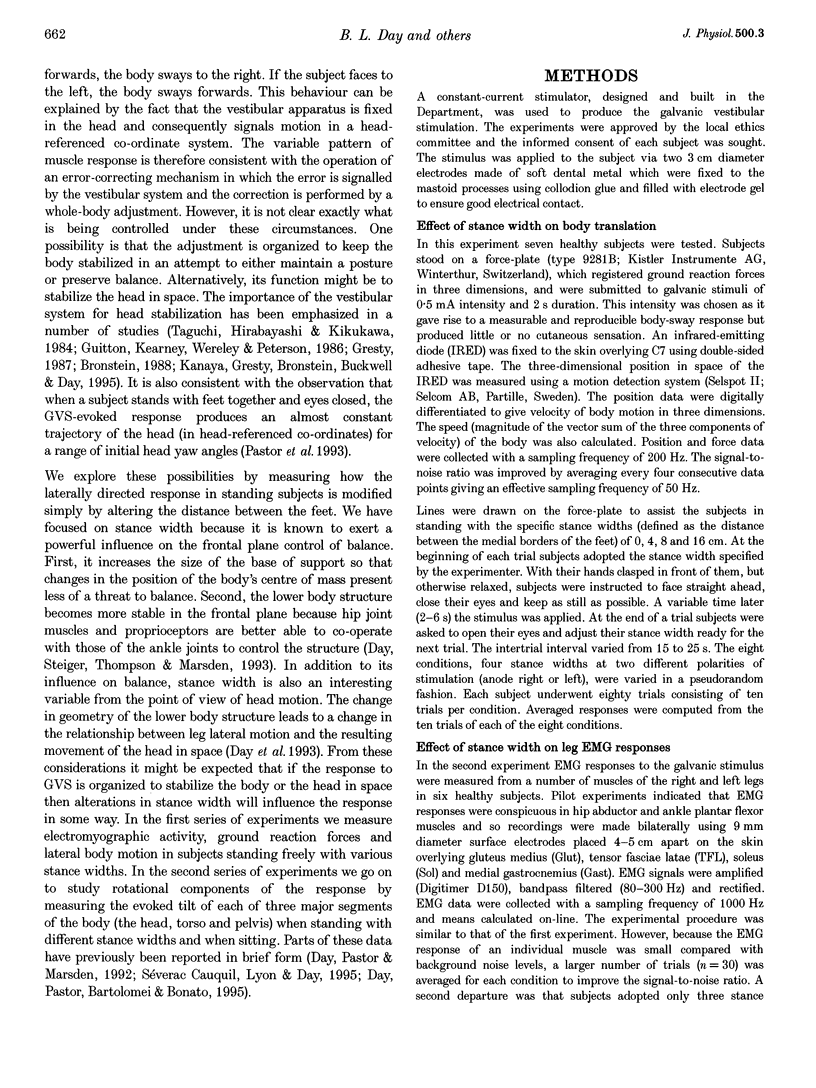
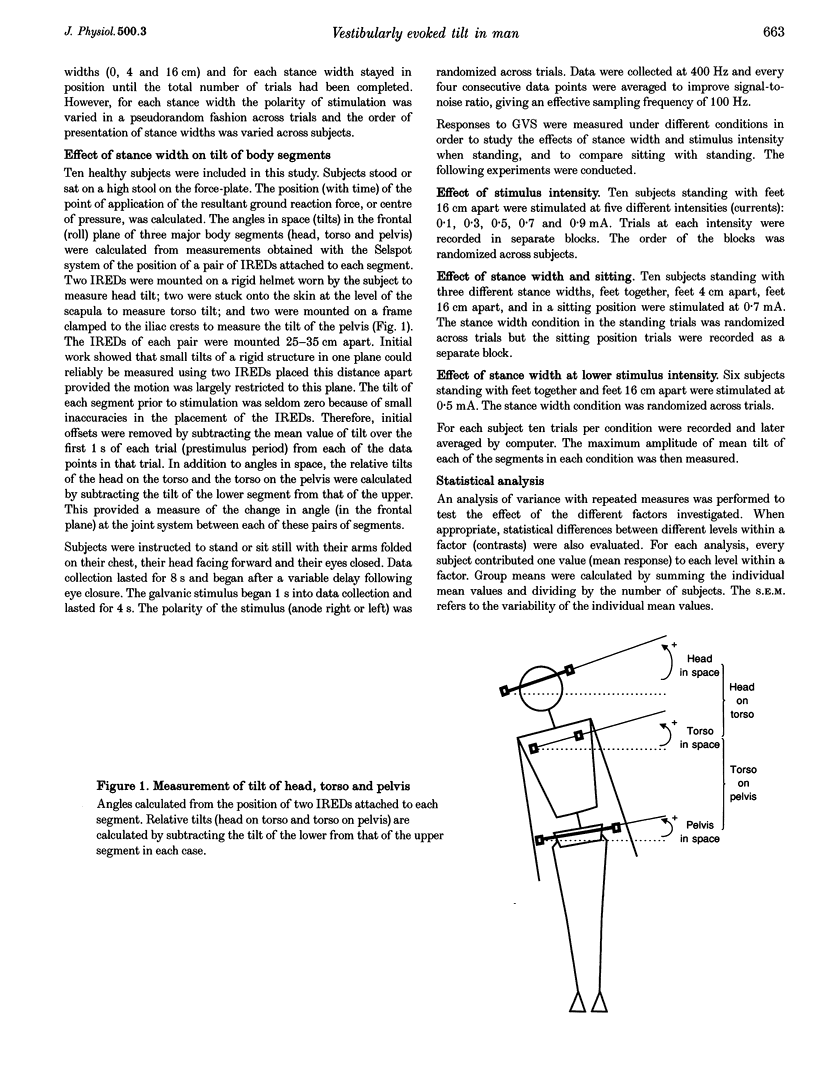

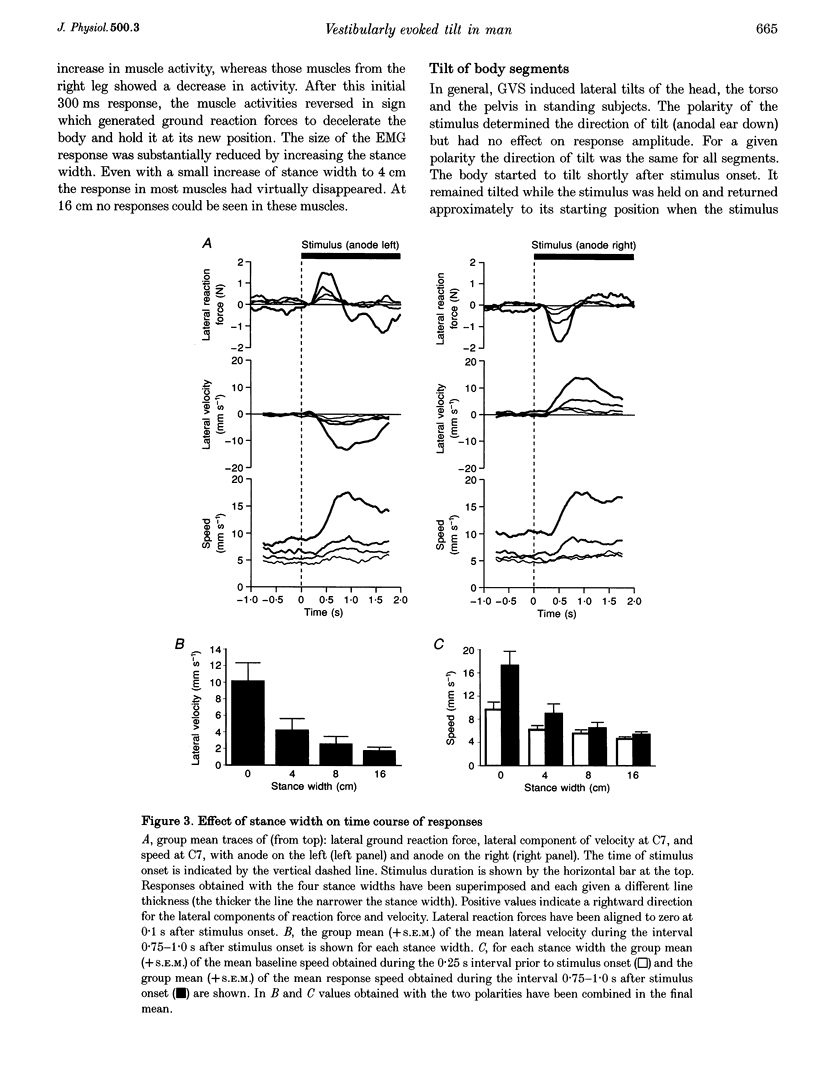
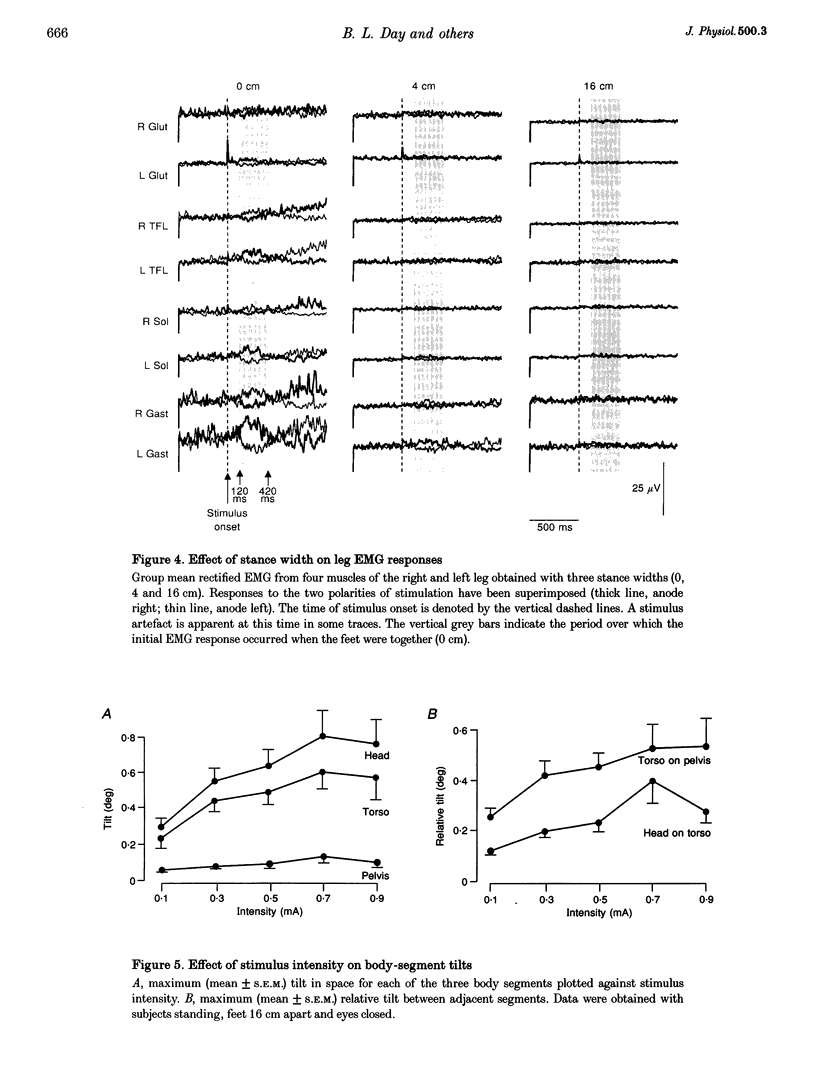

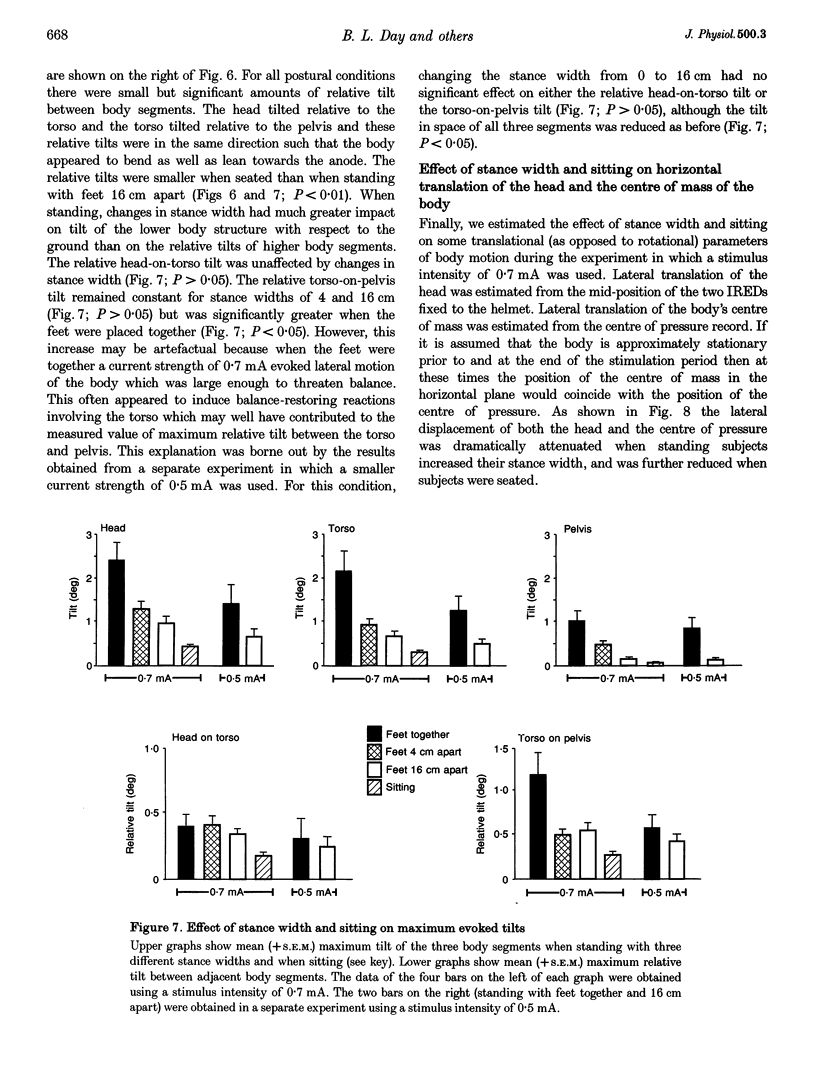
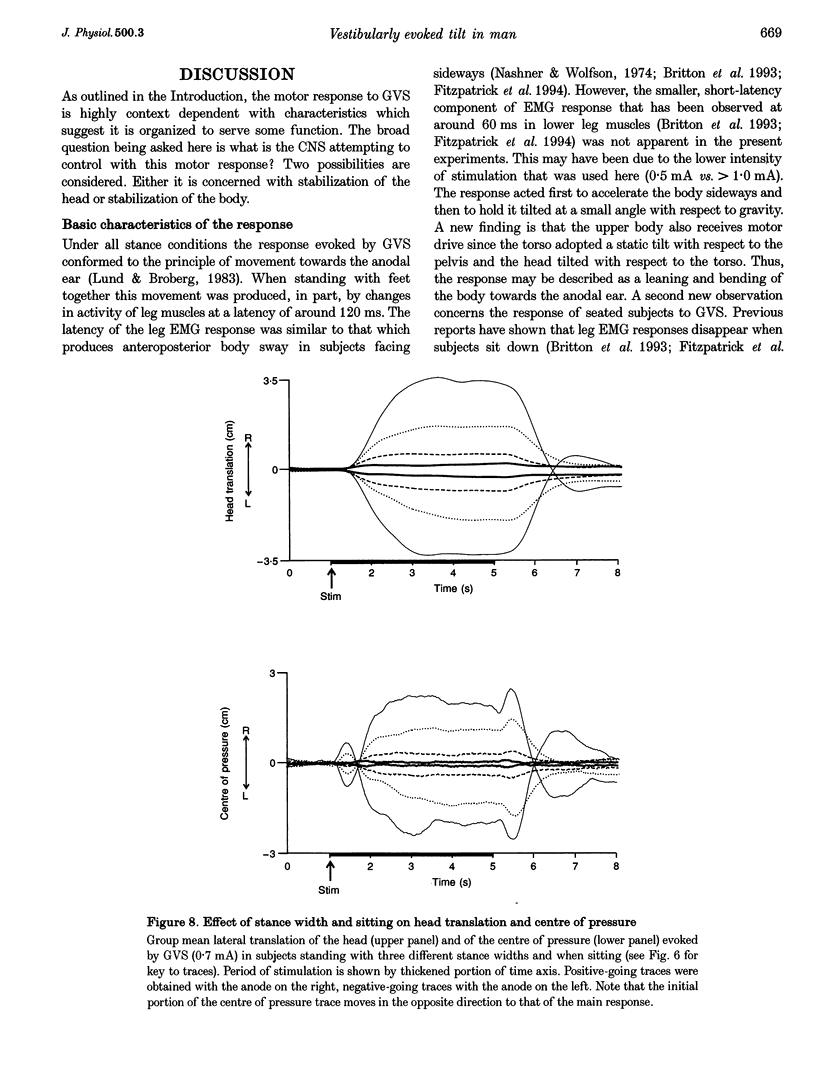
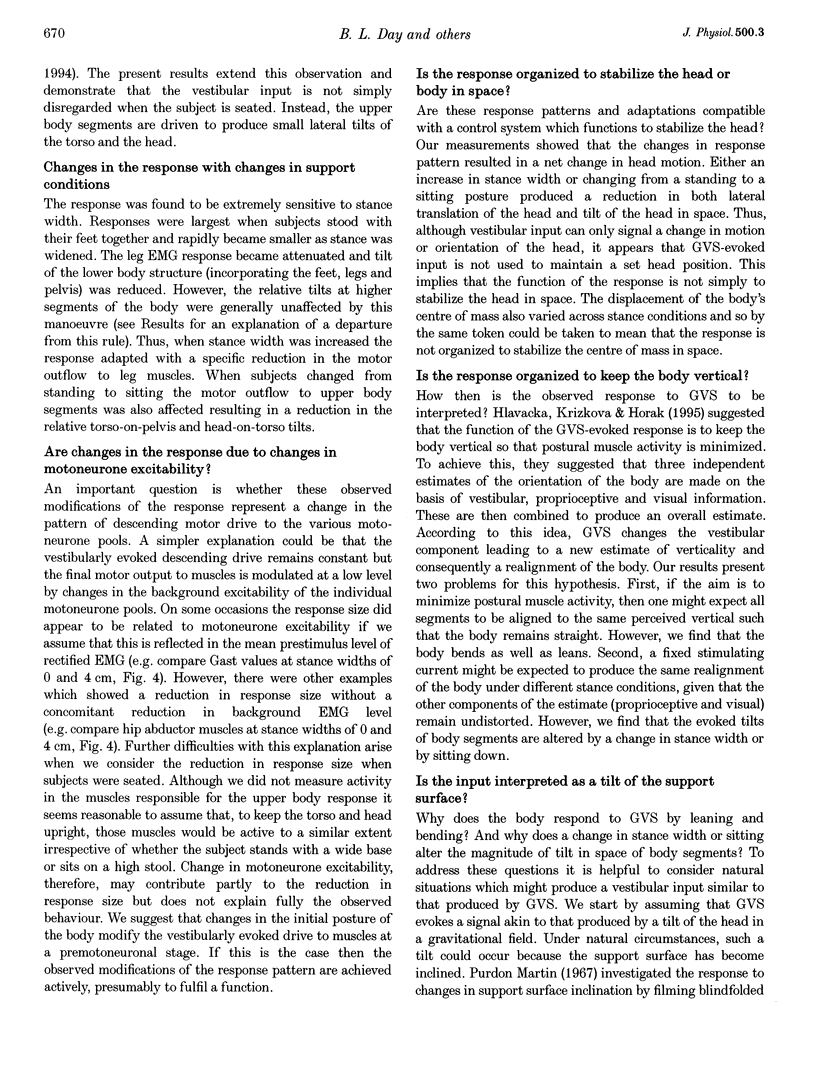
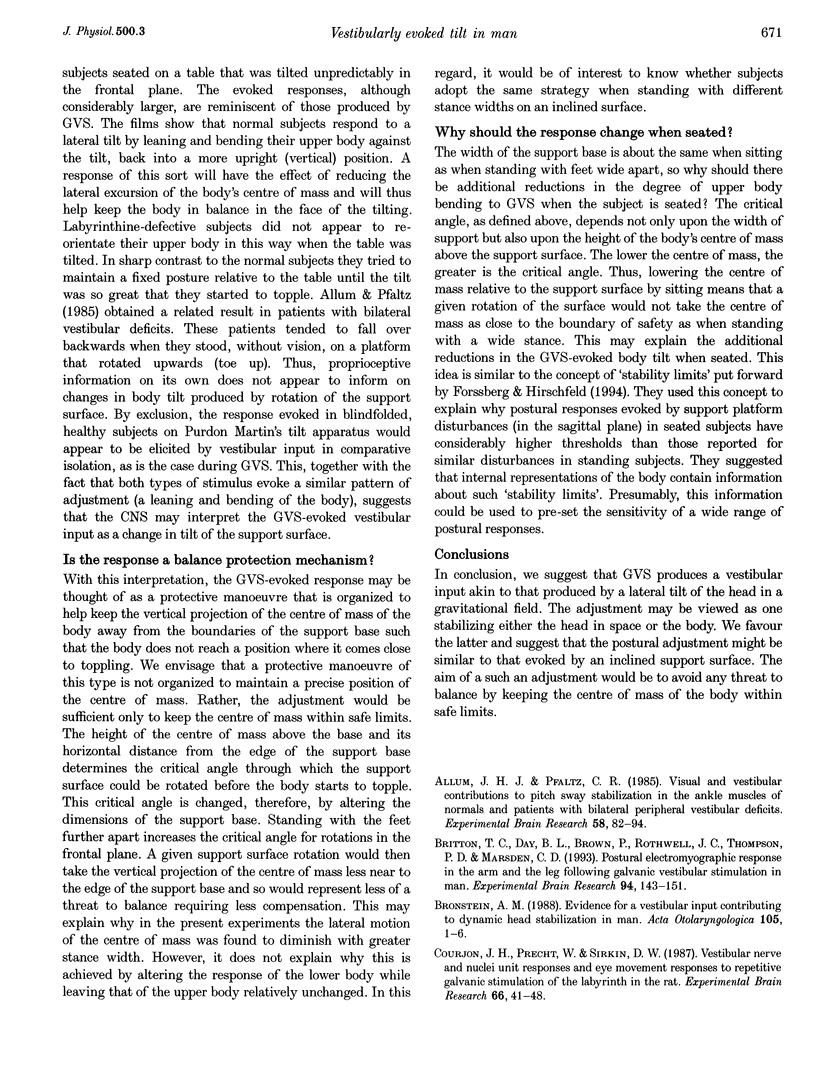
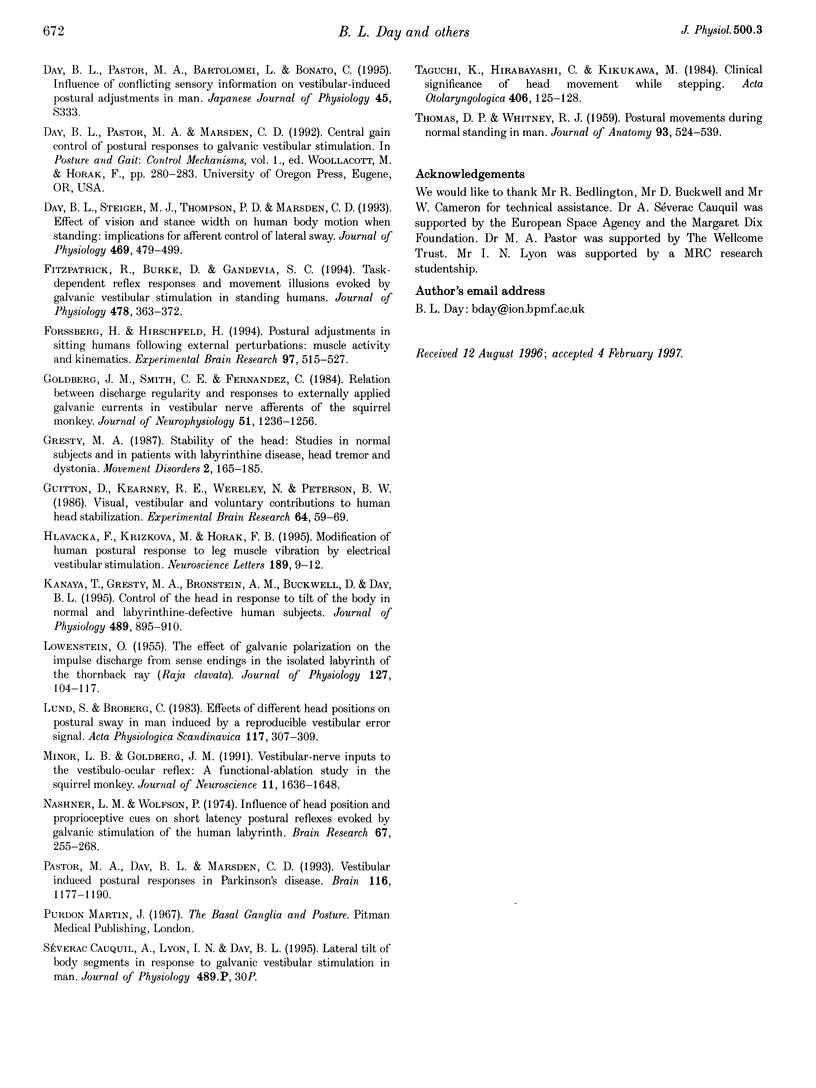
Images in this article
Selected References
These references are in PubMed. This may not be the complete list of references from this article.
- Allum J. H., Pfaltz C. R. Visual and vestibular contributions to pitch sway stabilization in the ankle muscles of normals and patients with bilateral peripheral vestibular deficits. Exp Brain Res. 1985;58(1):82–94. doi: 10.1007/BF00238956. [DOI] [PubMed] [Google Scholar]
- Britton T. C., Day B. L., Brown P., Rothwell J. C., Thompson P. D., Marsden C. D. Postural electromyographic responses in the arm and leg following galvanic vestibular stimulation in man. Exp Brain Res. 1993;94(1):143–151. doi: 10.1007/BF00230477. [DOI] [PubMed] [Google Scholar]
- Courjon J. H., Precht W., Sirkin D. W. Vestibular nerve and nuclei unit responses and eye movement responses to repetitive galvanic stimulation of the labyrinth in the rat. Exp Brain Res. 1987;66(1):41–48. doi: 10.1007/BF00236200. [DOI] [PubMed] [Google Scholar]
- Day B. L., Steiger M. J., Thompson P. D., Marsden C. D. Effect of vision and stance width on human body motion when standing: implications for afferent control of lateral sway. J Physiol. 1993 Sep;469:479–499. doi: 10.1113/jphysiol.1993.sp019824. [DOI] [PMC free article] [PubMed] [Google Scholar]
- Fitzpatrick R., Burke D., Gandevia S. C. Task-dependent reflex responses and movement illusions evoked by galvanic vestibular stimulation in standing humans. J Physiol. 1994 Jul 15;478(Pt 2):363–372. doi: 10.1113/jphysiol.1994.sp020257. [DOI] [PMC free article] [PubMed] [Google Scholar]
- Forssberg H., Hirschfeld H. Postural adjustments in sitting humans following external perturbations: muscle activity and kinematics. Exp Brain Res. 1994;97(3):515–527. doi: 10.1007/BF00241545. [DOI] [PubMed] [Google Scholar]
- Goldberg J. M., Smith C. E., Fernández C. Relation between discharge regularity and responses to externally applied galvanic currents in vestibular nerve afferents of the squirrel monkey. J Neurophysiol. 1984 Jun;51(6):1236–1256. doi: 10.1152/jn.1984.51.6.1236. [DOI] [PubMed] [Google Scholar]
- Gresty M. Stability of the head: studies in normal subjects and in patients with labyrinthine disease, head tremor, and dystonia. Mov Disord. 1987;2(3):165–185. doi: 10.1002/mds.870020304. [DOI] [PubMed] [Google Scholar]
- Guitton D., Kearney R. E., Wereley N., Peterson B. W. Visual, vestibular and voluntary contributions to human head stabilization. Exp Brain Res. 1986;64(1):59–69. doi: 10.1007/BF00238201. [DOI] [PubMed] [Google Scholar]
- Hlavacka F., Krizková M., Horak F. B. Modification of human postural response to leg muscle vibration by electrical vestibular stimulation. Neurosci Lett. 1995 Apr 7;189(1):9–12. doi: 10.1016/0304-3940(95)11436-z. [DOI] [PubMed] [Google Scholar]
- Kanaya T., Gresty M. A., Bronstein A. M., Buckwell D., Day B. Control of the head in response to tilt of the body in normal and labyrinthine-defective human subjects. J Physiol. 1995 Dec 15;489(Pt 3):895–910. doi: 10.1113/jphysiol.1995.sp021102. [DOI] [PMC free article] [PubMed] [Google Scholar]
- LOWENSTEIN O. The effect of galvanic polarization on the impulse discharge from sense endings in the isolated labyrinth of the thornback ray (Raja clavata). J Physiol. 1955 Jan 28;127(1):104–117. doi: 10.1113/jphysiol.1955.sp005241. [DOI] [PMC free article] [PubMed] [Google Scholar]
- Lund S., Broberg C. Effects of different head positions on postural sway in man induced by a reproducible vestibular error signal. Acta Physiol Scand. 1983 Feb;117(2):307–309. doi: 10.1111/j.1748-1716.1983.tb07212.x. [DOI] [PubMed] [Google Scholar]
- Minor L. B., Goldberg J. M. Vestibular-nerve inputs to the vestibulo-ocular reflex: a functional-ablation study in the squirrel monkey. J Neurosci. 1991 Jun;11(6):1636–1648. doi: 10.1523/JNEUROSCI.11-06-01636.1991. [DOI] [PMC free article] [PubMed] [Google Scholar]
- Nashner L. M., Wolfson P. Influence of head position and proprioceptive cues on short latency postural reflexes evoked by galvanic stimulation of the human labyrinth. Brain Res. 1974 Feb 22;67(2):255–268. doi: 10.1016/0006-8993(74)90276-5. [DOI] [PubMed] [Google Scholar]
- Pastor M. A., Day B. L., Marsden C. D. Vestibular induced postural responses in Parkinson's disease. Brain. 1993 Oct;116(Pt 5):1177–1190. doi: 10.1093/brain/116.5.1177. [DOI] [PubMed] [Google Scholar]
- THOMAS D. P., WHITNEY R. J. Postural movements during normal standing in man. J Anat. 1959 Oct;93:524–539. [PMC free article] [PubMed] [Google Scholar]
- Taguchi K., Hirabayashi C., Kikukawa M. Clinical significance of head movement while stepping. Acta Otolaryngol Suppl. 1984;406:125–128. doi: 10.3109/00016488309123018. [DOI] [PubMed] [Google Scholar]



